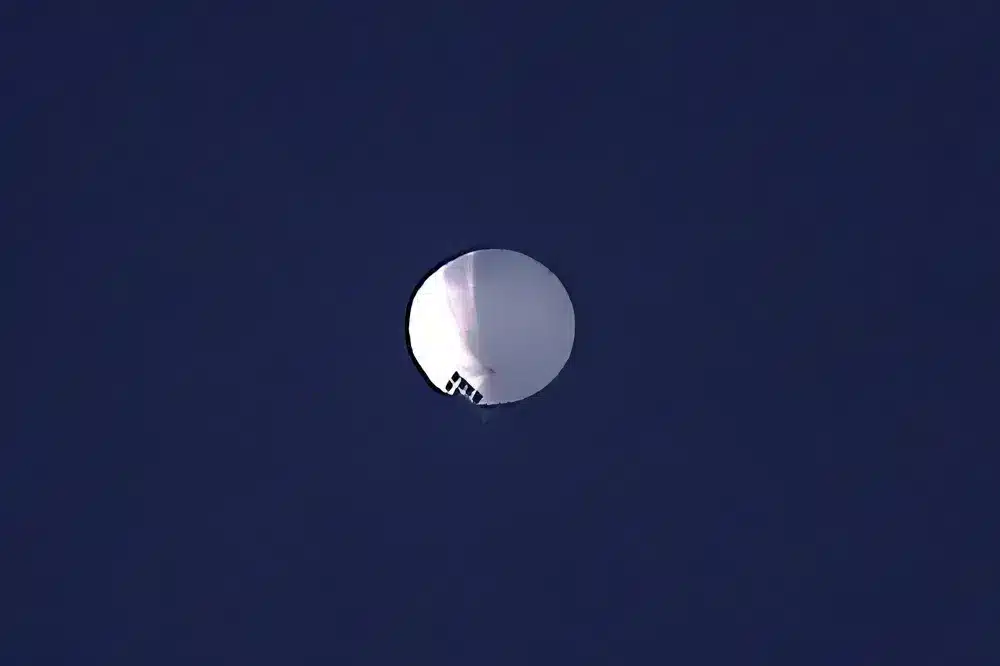World
CHINA 2023: Chinese Balloon Soars Across US; Blinken Scraps Beijing Trip

WASHINGTON — The U.S. Friday, a huge, high-altitude Chinese balloon flew over the United States. The Pentagon accused China of spying, but China denied it. Antony Blinken, the Secretary of State, abruptly canceled a high-stakes trip to Beijing that was meant to ease tensions between the United States and China.
People using binoculars and telephoto lenses tried to find the “spy balloon” in the sky as it flew east over Kansas and Missouri at 60,000 feet. Fuzzy videos flooded social media sites.
Despite China’s claim that the balloon was merely a weather research “airship” that had blown off course, Blinken was canceled. The Pentagon didn’t believe that at all, and neither did China, which said that the balloon, which was about the size of two school buses, wasn’t used for spying and couldn’t go very far.
The balloon was found over sensitive military sites in Montana. By noon, it had moved east over the center of the United States and was expected to stay there for several days, according to officials.
The news made things even worse between the US and China, which have been getting worse for years because of many things. Nonetheless, U.S. officials maintained that diplomatic channels were open and that Blinken was willing to visit China at “an appropriate time.”
Biden Delcined To Comment About The China Balloon
President Joe Biden declined to comment when asked about the matter at an economic event. Former President Donald Trump, who is running for reelection in 2024, and former South Carolina Governor Nikki Haley, who is running for reelection in 2024, said the U.S. should pop the balloon right away.
According to White House press secretary Karine Jean-Pierre, Biden was first briefed about the Chinese surveillance balloon on Tuesday. She should have explained why the administration waited until Thursday to express its concerns.
According to a senior defense official, the United States has prepared fighter jets, including F-22s, to shoot down the balloon if ordered. The Pentagon eventually advised against it, noting that even though the balloon was over a sparsely populated area of Montana, its size could create a large debris field to endanger people.
On Friday, Pentagon press secretary Brig. Gen. Pat Ryder refused to say whether there was any new consideration of shooting down the balloon.
Ryder stated it was about 60,000 feet in altitude, maneuverable, and had changed course. He stated that it was no longer a threat.
Blinkin Trip Cancelled
Regarding Blinken’s trip, Jean-Pierre stated that a diplomatic visit to China was unnecessary. “The presence of this balloon in our airspace… is a clear violation of our sovereignty as well as international law, and it is unacceptable that this happened,” she said.
According to a State Department official, Blinken and Deputy Secretary of State Wendy Sherman protested to the Chinese Embassy’s top official on Wednesday, the day before the Pentagon announced the balloon’s discovery.
According to Pentagon officials, it was spotted over Montana, home to one of America’s three nuclear missile silo fields at Malmstrom Air Force Base.
Several Republican lawmakers have chastised the administration for not taking stronger action against China before this. And allowing Blinken to go ahead with his trip could have made Biden even more vulnerable to their complaints when he is dealing with the new Republican-led U.S. House.
According to weather experts, China’s claim that the balloon had gone off course was not implausible. China’s account of Westerlies carrying a balloon to the western United States was “absolutely possible – not possible, likely,” said Dan Jaffe, an atmospheric chemistry professor at the University of Washington.
Nonetheless, multiple U.S. officials called the presence of the balloon “unacceptable” and said Blinken delivered that message to Chinese State Councilor Wang Yi when he told them he was postponing his trip on Friday.
China Denounces Surveillance Attempts
According to State Department spokesman Ned Price, Blinken told Wang that the “U.S. is committed to diplomatic engagement and maintaining open lines of communication and that he would be prepared to visit Beijing as soon as conditions allow.”
Blinken’s long-awaited meetings with senior Chinese officials were seen as a possible way for both countries to find some areas of common ground amid major disagreements over Taiwan, human rights, China’s claims in the South China Sea, North Korea, Russia’s war in Ukraine, trade policy, and climate change.
Even though Biden and Chinese President Xi Jinping agreed to the trip at a meeting in Indonesia in November, it hasn’t been officially announced yet. However, officials in both Beijing and Washington have been talking about Blinken’s arrival on Sunday and Monday for meetings.
China, which angrily denounces surveillance attempts by the U.S. and others over areas it considers to be its territory and once shot down an American spy plane and imprisoned its crew on Hainan Island, was relatively conciliatory in response to U.S. complaints.
The Chinese foreign ministry said in a statement that came close to an apology that the balloon was a civilian airship used primarily for meteorological research. According to the report, the airship had limited “self-steering” capabilities and had “deviated far from its planned course” due to winds.
“The statement said that the Chinese side regrets that the airship accidentally entered U.S. airspace due to “force majeure,” which is a legal term for things that are out of one’s control.”
SOURCE – (AP)
World
Ukraine Claims It Shot Down A Russian Strategic Bomber As Moscow’s Missiles Kill 8 Ukrainians

Kiev, Ukraine — Ukraine’s air force claimed on Friday that it shot down a Russian strategic bomber, but Moscow officials said the plane landed in a sparsely populated area due to a malfunction following a combat mission.
Neither of the claims could be independently verified. Previous Ukrainian claims of shooting down Russian jets throughout the more than two-year conflict were met with silence or denials from Moscow.
AP News – VOR News Image
Ukraine Claims It Shot Down A Russian Strategic Bomber As Moscow’s Missiles Kill 8 Ukrainians
Meanwhile, Russian missiles attacked cities in Ukraine’s central Dnipro area, killing eight people, including a 14-year-old girl and an eight-year-old boy, and wounded 28, according to local officials.
Ukraine President Volodymyr Zelenskyy reiterated Kyiv authorities’ almost daily calls for more Western air defense systems, citing a similarity to how Israel countered a recent Iranian attack.
Missile and drone assaults can be prevented, he said on social media site X: “This has been demonstrated in the skies over the Middle East, and it should also work in Europe.”
Foreign Minister Dmytro Kuleba stated, “Children must not be killed in airstrikes in modern Europe.”
Russia’s air force is far more powerful than Ukraine’s, but sophisticated missile systems supplied by Kyiv’s Western allies pose a significant threat to Russian aviation as the Kremlin’s forces slowly advance along the approximately 1,000-kilometer (620-mile) front line in what has become a grinding war of attrition. Ukrainian officials say they expect a strong Russian onslaught this summer.
Ukraine says the air force and military intelligence worked together to shoot down the Tu-22M3 bomber using anti-aircraft missiles. Russia frequently utilizes the bomber to launch Kh-22 cruise missiles at Ukrainian targets from within its own airspace. The plane can also transport nuclear warheads.
AP news – VOR News Image
Ukraine Claims It Shot Down A Russian Strategic Bomber As Moscow’s Missiles Kill 8 Ukrainians
The Russian military ministry reported that the warplane crashed “in a deserted area” in the southern province of Stavropol, hundreds of kilometers (miles) from the Ukrainian border.
According to the ministry, three crew members were rescued after ejecting from the aircraft, while a fourth is still missing. However, Stavropol Governor Vladimir Vladimirov reported one of the rescued pilots died.
On Christmas Eve, Ukraine reported that it had shot down two Russian fighter jets. In January, the Ukrainian air force claimed to have shot down a Russian early warning and control plane as well as a crucial command center aircraft that feeds intelligence to ground troops, appearing to deal a serious blow to the Kremlin’s forces. The following month, Ukraine claimed it had shot down another early warning and control plane.
In January, Moscow accused Kyiv of shooting down a Russian military transport plane carrying Ukrainian POWs bound for a prisoner swap.
Russian forces launched a joint aerial attack overnight, using 22 different types of missiles and 14 Shahed drones, according to the Ukrainian air force. It stated that all of the drones and 15 missiles had been intercepted.
AP News – VOR News Image
Ukraine Claims It Shot Down A Russian Strategic Bomber As Moscow’s Missiles Kill 8 Ukrainians
Ukraine’s National Railway Operator reported that the attack targeted both metropolitan areas and train infrastructure in the Dnipro region. Employee Oksana Storozhenko, mother of two teenage sons, was among those slain in the strikes, according to reports.
SOURCE – (AP)
U.K News
Ukraine, Israel Aid Back On Track As House Pushes Toward Weekend Votes

WASHINGTON – With rare bipartisan support, the House advanced Friday on a $95 billion foreign aid plan for Ukraine, Israel, Taiwan, and humanitarian aid, as a coalition of members helped it cross a procedural hurdle and reach final votes this weekend. Friday’s vote delivered an unusual outcome in the generally hyper-partisan House, with Democrats voting 316-94 in support of Republican Speaker Mike Johnson’s plan. The final House approval might come this weekend, when the package is delivered to the Senate.
It was a success for Speaker Mike Johnson’s strategy, which he put into action last week after agonizing over the legislation for two months. Nonetheless, Johnson has spent the past 24 hours making the rounds on conservative media, attempting to salvage support for wartime funding, particularly for Ukraine as it faces a critical moment in its battle with Russia, but also for his own job, as the restive right flank threatens to oust him over the effort.

aawsat – VOR News Image
Ukraine, Israel Aid Back On Track As House Pushes Toward Weekend Votes
“There’s a lot of misinformation about what we’re doing here and why,” Johnson said to The Mark Levin Show’s conservative host.
“Ukrainians urgently require lethal aid right now. “We cannot allow Vladimir Putin to roll through another country and take it,” he stated of the Russian president’s invasion of Ukraine. “These are very serious matters with global implications.”
After months of delay, the House moved slowly but methodically this week after Johnson decided to move forward. President Joe Biden quickly endorsed the speaker’s plan, and Donald Trump, the Republican assumed presidential nominee who opposes most foreign aid to Ukraine, has not slowed the speaker’s progress.
“The world is watching what Congress does,” the White House stated. “Passing this legislation would send a powerful message about the strength of American leadership at a pivotal moment.”
In an extremely rare move, members of the House Rules Committee banded together late Thursday in a near-midnight vote, with four Democrats supporting a procedural step, to push the package past the Republican majority’s three hardline holdouts and send it to the House floor for debate, 9-3. It was a moment unlike any other in recent House history.
Johnson will need to rely on Democrats again on Friday to pass the next procedural vote and block Republican amendments that might kill the plan. One proposed by extreme Rep. Marjorie Taylor Greene would cut Ukraine’s funding to zero.
ap – VOR News Image
Ukraine, Israel Aid Back On Track As House Pushes Toward Weekend Votes
Greene has filed a “motion to vacate” the speaker from office, which has at least one Republican co-sponsor, Rep. Thomas Massie of Kentucky. It may initiate a bid to oust Johnson from the speaker’s office if she calls it up for a vote, similar to how Republicans removed Kevin McCarthy from the job last November.
With one of the most slender House majorities in modern history, Johnson can only afford to lose one or two Republican votes to pass any legislation. That dynamic has pushed him into the arms of Democrats as he seeks votes to enact the legislation.
Johnson cannot tailor the plan as the ultra-conservatives seek without risking losing Democratic support. It has prompted him to abandon severe security measures to control migrants at the US-Mexico border, among other goals.
At best, Johnson has been able to divide a Senate-passed version of the bill into different portions, as House Republicans prefer, and the final votes will be on various measures — for Ukraine, Israel, and Indo-Pacific partners.
The plan would also include a fourth clause, which incorporates several Republican demands that Democrats support or are ready to accept. Proposals include allowing the United States to seize frozen Russian central bank assets to rebuild Ukraine, imposing sanctions on Iran, Russia, China, and fentanyl trafficking criminal organizations, and potentially banning the video app TikTok if its Chinese owner does not sell its stake within a year.

Bloomberg – VOR News Image
Ukraine, Israel Aid Back On Track As House Pushes Toward Weekend Votes
Passing each package, which is set to be voted on Saturday, would require Johnson to establish intricate bipartisan coalitions, with Democrats assuring Ukraine funding is authorized but some left-leaning progressives refusing to support military aid for Israel due to the destruction of Gaza.
The components would then be automatically stitched back together into a single package and delivered to the Senate, where hardliners are plotting procedural measures to postpone final passage.
SOURCE – (AP)
World
Argentina Asks To Join NATO As President Milei Seeks A More Prominent Role For His Nation

BUENOS AIRES, Argentina – Argentina formally sought on Thursday to join NATO as a worldwide partner, paving the stage for further political and security cooperation at a time when President Javier Milei’s right-wing government seeks to strengthen ties with Western powers and attract investment.
The request came as NATO Deputy General Secretary Mircea Geoana met with visiting Argentine Defense Minister Luis Petri in Brussels to discuss regional security problems.

Union – VOR News Image
Argentina Asks To Join NATO As President Milei Seeks A More Prominent Role For His Nation
Geoana said he supported Argentina’s bid to become an accredited partner in the alliance, which is a valuable role short of “ally” for nations outside NATO’s geographical territory and not compelled to participate in joint military actions. NATO membership is currently confined to European countries, Turkey, Canada, and the United States.
The classification may provide Argentina with access to modern technology, security systems, and training that it did not previously have, according to the Argentine presidency.
“Argentina plays an important role in Latin America,” Geoana stated at NATO headquarters. “Closer political and practical cooperation could benefit us both.”
Milei has been promoting a radical libertarian agenda aimed at undoing years of protectionist trade policies, overspending, and debilitating international debt that have thrown the country’s economy into disarray.

AP – VOR News Image
Argentina Asks To Join NATO As President Milei Seeks A More Prominent Role For His Nation
Over the last four months as president, he has reshaped Argentina’s foreign policy to one of almost unconditional support for the United States, as part of an effort to restore Argentina’s global economic prominence after previous administrations allowed relations with Washington and European allies to deteriorate.
Milei’s government is likewise looking for security gains from improved ties with Western countries. On Thursday, the US government revealed that it would provide Argentina with $40 million in foreign military financing for the first time in more than two decades, allowing critical US allies such as Israel to purchase American weapons.
The money, meant to assist Argentina equip and modernize its military, will help cover the cost of 24 American F-16 fighter aircraft purchased from Denmark earlier this week. Defense Minister Petri described the acquisition of the upgraded jets as “the most important military purchase since Argentina’s return to democracy” in 1983. Milei’s political opponents have criticized the $300 million price tag, which comes as he lowers government expenditure.
Formal partnership with NATO requires the agreement of all 32 NATO countries. Argentina’s relations with crucial NATO partner Britain have been strained since 1982, when the two went to war over the disputed Falkland Islands in the South Atlantic.
The Alliance’s other global partners include Afghanistan, Australia, Iraq, Japan, the Republic of Korea, Mongolia, New Zealand, and Pakistan. Colombia is now NATO’s lone partner in Latin America.
Giving a country the title of “global partner” does not guarantee that NATO allies will defend it in the case of an attack. That pledge, outlined in Article 5 of the North Atlantic Treaty Organization’s founding treaty, is limited to full members of the alliance.

Express – VOR News Image
Argentina Asks To Join NATO As President Milei Seeks A More Prominent Role For His Nation
NATO’s conversation with Argentina began in the early 1990s. Former President Bill Clinton labeled Argentina a “major non-NATO ally” in 1998, partly as a symbolic gesture to reward the pro-American government at the time for contributing soldiers on peacekeeping operations in Bosnia.
SOURCE – (AP)
-
News5 months ago
Death Toll From Flooding In Somalia Climbs To Nearly 100
-
Business5 months ago
Google Will Start Deleting ‘Inactive’ Accounts In December. Here’s What You Need To Know
-
Entertainment5 months ago
Merriam-Webster’s 2023 Word Of The Year Is ‘Authentic’
-
Sports5 months ago
Panthers Fire Frank Reich In His First Season With Team Off To NFL-Worst 1-10 Record
-
Celebrity5 months ago
Elon Musk Visits Destroyed Kibbutz and Meets Netanyahu in Wake of Antisemitic Post
-
Celebrity5 months ago
Shane MacGowan, Lead Singer Of The Pogues And A Laureate Of Booze And Beauty, Dies At Age 65


















































